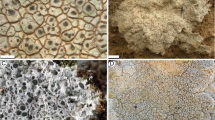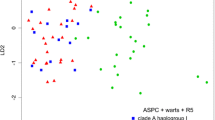Abstract
Tuber borchii (Ascomycota, Pezizales) is a highly valued truffle sold in local markets in Italy. Despite its economic importance, knowledge on its distribution and genetic structure is scarce. The objective of this work was to investigate the factors shaping the genetic structure of T. borchii using 61 representative specimens with a broad distribution throughout Italy. In spite of the lack of morphological differences, phylogenetic and coalescent-based analyses using four loci identified two genetically isolated groups sympatrically distributed. The low levels of divergence between the two clades may be the result of recent range expansions from geographically distinct refugia, potentially mediated by reforestation using coniferous species that are common ectomycorrhizal symbionts for both groups.



Similar content being viewed by others
References
Amicucci A, Rossi I, Potenza L, Zambonelli A, Agostini D, Palma F, Stocchi V (1996) Identification of ectomycorrhizae from Tuber species by RFLP analysis of the ITS region. Biotechnol Lett 18:821–826. doi:10.1007/BF00127896
Amicucci A, Guidi C, Zambonelli A, Potenza L, Stocchi V (2000) Multiplex PCR for the identification of white Tuber species. FEMS Microbiol Lett 189:265–269. doi:10.1111/j.1574-6968.2000.tb09241.x
Aylor DL, Price EW, Carbone I (2006) SNAP: combine and map modules for multilocus population genetic analysis. Bioinformatics 22:1399–1401. doi:10.1093/bioinformatics/btl136
Beerli P, Felsenstein J (1999) Maximum likelihood estimation of migration rates and effective population numbers in two populations. Genetics 152:763–773
Beerli P, Felsenstein J (2001) Maximum likelihood estimation of a migration matrix and effective population sizes in n subpopulations by using a coalescent approach. PNAS 98:4563–4568. doi:10.1073/pnas.081068098
Brandley MC, Schmitz A, Reeder T (2005) Partitioned Bayesian analyses, partition choice and phylogenetic relationships of scincid lizards. Syst Biol 54:373–390. doi:10.1080/10635150590946808
Castoe TA, Parkinson CL (2006) Bayesian mixed models and the phylogeny of pitvipers (Serpentes: Viperidae). Mol Phylogenet Evol 39:91–110. doi:10.1016/j.ympev.2005.12.014
Ceruti A, Fontana A, Nosenzo C (2003) Le Specie Europee del Genere Tuber. Museo Regionale di Scienze Naturali, Torino
Chapela IH, Garbelotto M (2004) Phylogeography and evolution in Matsutake and close allies inferred by analyses of ITS sequences and AFLPs. Mycologia 96:730–741
El Karkouri K, Murat C, Zampieri E, Bonfante P (2007) Identification of internal transcribed spacer sequence motifs in truffles: a first step toward their DNA bar coding. Appl Environ Microb 73(16):5320–5330. doi:10.1128/AEM.00530-07
Felsenstein J (1985) Confidence limits on phylogenies: an approach using the bootstrap. Evolution 39:783–791
Gardes M, Bruns TD (1993) ITS primers with enhanced specificity for basidiomycetes—application to the identification of mycorrhizae and rusts. Mol Ecol 2:113–118
Giomaro G, Zambonelli A, Sisti D, Cecchini M, Evangelista V, Stocchi V (2000) Anatomical and morphological characterization of mycorrhizas of five strains of Tuber borchii Vittad. Mycorrhiza 10:107–114. doi:10.1007/s005720000065
Glass LN, Donaldson GC (1995) Development of primer sets designed for use with the PCR to amplify conserved genes from filamentous Ascomycetes. Appl Environ Microb 61:1323–1330
Hall TA (1999) BioEdit: a user-friendly biological sequence alignment editor and analysis program for Windows 95/98/NT. Nucleic Acids Symp Ser 41:95–98
Hall IR (2007) Truficultura en Nueva Zelanda. In: Reynas DS (ed) Truficultura. Fundamentos y técnicas Ediciones Mundi-Prensa, Madrid, pp 495–502
Hall IR, Lyon AJE, Wang Y, Sinclair L (1998) Ectomycorrhizal fungi with edible fruiting bodies. 2. Boletus edulis. Econ Bot 52:44–56. doi:10.1007/BF02861294
Hall IR, Wang Y, Amicucci A (2003) Cultivation of edible ectomycorrhizal mushrooms. Trends Biotechnol 21:433–438. doi:10.1016/S0167-7799(03)00204-X
Hall IR, Brown G, Zambonelli A (2007) Taming the truffle. The history lore and science of the ultimate mushroom. Timber, Portland
Hewitt GM (1996) Some genetic consequences of ice age, and their role in divergence and speciation. Biol J Linn Soc 58:247–276
Hewitt G (2000) The genetic legacy of the quaternary ice ages. Nature 405:907–913
Hey J, Nielsen R (2004) Multilocus methods for estimating population sizes, migration rates and divergence time, with applications to the divergence of Drosophila pseudoobscura and D. persimilis. Genetics 167:747–760
Hudson RR, Slatkin M, Maddison WP (1992) Estimation of levels of gene flow from DNA sequence data. Genetics 132:583–589
Huelsenbeck JP, Ronquist F (2001) MRBAYES: Bayesian inference of phylogenetic trees. Bioinformatics 17:754–755
Iotti M, Amicucci A, Stocchi V, Zambonelli A (2002) Morphological and molecular characterisation of mycelia of some Tuber species in pure culture. New Phytol 155:499–505. doi:10.1046/j.1469-8137.2002.00486.x
Jeandroz S, Murat C, Wang Y, Bonfante P, Le Tacon F (2008) Molecular phylogeny and historical biogeography of the genus Tuber, the ‘true truffles’. J Biogeogr 35(5):815–829. doi:10.1111/j.1365-2699.2007.01851.x
Lazzari B, Caprera A, Cosentino C, Stella A, Milanesi L, Viotti A (2007) ESTuber db: an online database for Tuber borchii EST sequences. BMC Bioinformatics 8(Suppl 1):S13. doi:10.1186/1471-2105-8-S1-S13
Markwordt J, Doshi R, Carbone I (2003) Snap clade and matrix. Department of Plant Pathology, North Carolina State University, Raleigh. Available via DIALOG. http://www.cals.ncsu.edu/plantpath/faculty/carbone/home.html Accessed 15 Jan 2008
Martin F, Selosse MA, Tacon FL (1999) The nuclear rDNA intergenic spacer of the ectomycorrhizal basidiomycete Laccaria bicolor: structural analysis and allelic polymorphism. Microbiology 145:1605–1611
Mello A, Murat C, Vizzini A, Gavazza V, Bonfante P (2005) Tuber magnatum Pico, a species of limited geographical distribution: its genetic diversity inside and outside a truffle ground. Environ Microbiol 7:55–65. doi:10.1111/j.1462-2920.2004.00678.x
Mello A, Murat C, Bonfante P (2006) Truffles: much more than a prized and local fungal delicacy. FEMS Microbiol Lett 260(1):1–8. doi:10.1111/j.1574-6968.2006.00252.x
Murat C, Díez J, Luis P, Delaruelle C, Dupré C, Chevalier G, Bonfante P, Martin F (2004) Polymorphism at the ribosomal DNA ITS and its relation to postglacial re-colonization routes of the Perigord truffle Tuber melanosporum. New Phytol 164:401–441. doi:10.1111/j.1469-8137.2004.01189.x
Nielsen R, Wakeley J (2001) Distinguishing migration from isolation: a Markov chain Monte Carlo approach. Genetics 158:885–896
Paolocci F, Rubini A, Riccioni C, Topini F, Arcioni S (2004) Tuber aestivum and Tuber uncinatum: two morphotypes or two species? FEMS Microbiol Lett 235:109–115. doi:10.1016/j.femsle.2004.04.029
Pegler DN, Spooner BM, Young TWK (1993) British truffles. A revision of British hypogeous fungi. Royal Botanic Garden, Kew
Posada D, Buckley TR (2004) Model selection and model averaging in phylogenetics: advantages of Akaike information criterion and Bayesian approaches over likelihood ratio tests. Syst Biol 53:793–808. doi:10.1080/10635150490522304
Posada D, Crandall KA (1998) Modeltest: testing the model of DNA substitution. Bioinformatics 14:817–818
Price EW, Carbone I (2005) SNAP: workbench management tool for the evolutionary population genetic analysis. Bioinformatics 21:402–404. doi:10.1093/bioinformatics/bti003
R Development Core Team (2006) R: a language and environment for statistical computing. http://www.Royal-project.org
Rubini A, Topini F, Riccioni C, Paolocci F, Arcioni S (2004) Isolation and characterization of polymorphic microsatellite loci in white truffle (Tuber magnatum). Mol Ecol Notes 4:116–118. doi:10.1111/j.1471-8286.2004.00587.x
Rubini A, Paolocci F, Riccioni C, Vendramin GG, Arcioni S (2005) Genetic and phylogeographic structures of the symbiotic fungus Tuber magnatum. Appl Environ Microbiol 71(11):6584–6589. doi:10.1128/AEM.71.11.6584-6589.2005
Sisti D, Giomaro G, Zambonelli A, Rossi I, Ceccaroli P, Citterio B, Stocchi V, Benedetti PA (1998) In vitro mycorrhizal synthesis of micropropagated Tilia platyphyllos Scop. plantlets with Tuber borchii Vittad. mycelium in pure culture. Acta Hortic 457:379–387
Swofford DL (2000) PAUP*: phylogenetic analysis using parsimony (*and other methods). Version 4.0b10. Sinauer Associates, Sunderland
Taylor JW, Jacobson DJ, Kroken S, Kasuga T, Geiser DM, Hibbett DS, Fisher MC (2000) Phylogenetic species recognition and species concept in fungi. Fungal Genet Biol 31:21–32. doi:10.1006/fgbi.2000.1228
Taylor JW, Turner E, Townsend JP, Dettman JR, Jacobsom D (2006) Eukaryotic microbes, species recognition and the geographic limits of species: examples from the kingdom Fungi. Phil Trans R Soc B 361:1947–1963. doi:10.1098/rstb.2006.1923
Thompson JD, Higgins DG, Gibson TJ (2004) Clustal W: improving the sensitivity of progressive multiple alignment through sequence weighting, position-specific gap penalties and weight matrix choice. Nucleic Acid Res 22:4673–4680
Vittadini C (1831) Monographia tuberacearum. Felicis Rusconi, Milano
Walton WH (1948) Feret’s statistical diameter as a measure of particle size. Nature 162:329–330. doi:10.1038/162329b0
Wang Y, Tan ZM, Zhang DC, Murat C, Jeandroz S, Le Tacon F (2006) Phylogenetic relationship between Tuber pseudoexcavatum, a Chinese truffle, and other Tuber species based on parsimony and distance analysis of four different gene sequences. FEMS Microbiol Lett 259:269–281. doi:10.1111/j.1574-6968.2006.00283.x
Wedén C, Danell E, Camacho FJ, Backlund A (2004) The population of the hypogeous fungus Tuber aestivum syn. T. uncinatum on the island of Gotland. Mycorrhiza 14:19–23. doi:10.1007/s00572-003-0271-4
Wedén C, Danell E, Tibell L (2005) Species recognition in the truffle genus Tuber—the synonyms Tuber aestivum and Tuber uncinatum. Environ Microbiol 7:1535–1546. doi:10.1111/j.1462-2920.2005.00837.x
Zambonelli A, Iotti M, Rossi I, Hall I (2000a) Interaction between Tuber borchii and other ectomycorrhizal fungi in a field plantation. Mycol Res 104(6):698–702. doi:10.1017/S0953756299001811
Zambonelli A, Rivetti C, Percudani R, Ottonello S (2000b) TuberKey: a delta-based tool for the description and interactive identification of truffles. Mycotaxon 74:57–76
Zambonelli A, Iotti M, Giomaro G, Hall IR, Stocchi V (2002) T. borchii cultivation: an interesting perspective. Edible mycorrhizal mushrooms and their cultivation. In: Hall I, Wang Y, Danell E, Zambonelli A (eds), Edible mycorrhizal mushrooms. Proceedings of 2nd international workshop on edible ectomycorrhizal mushrooms, New Zealand Institute for Crop and Food Research Limited, CD room. 3–6 July 2001, Christchurch, New Zealand
Acknowledgments
We would like to thank Dr. Enrico Lancellotti for his assistance in statistical analyses of morphological data.
Author information
Authors and Affiliations
Corresponding author
Rights and permissions
About this article
Cite this article
Bonuso, E., Zambonelli, A., Bergemann, S.E. et al. Multilocus phylogenetic and coalescent analyses identify two cryptic species in the Italian bianchetto truffle, Tuber borchii Vittad.. Conserv Genet 11, 1453–1466 (2010). https://doi.org/10.1007/s10592-009-9972-3
Received:
Accepted:
Published:
Issue Date:
DOI: https://doi.org/10.1007/s10592-009-9972-3




